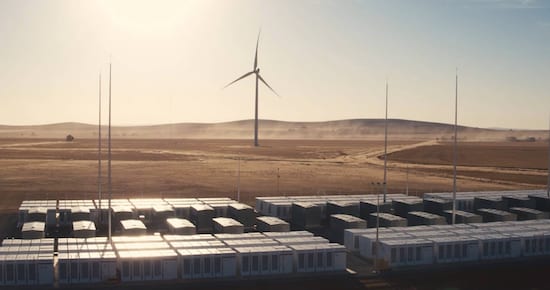French renewable energy developer Neoen, the owner and operator of the Tesla big battery in South Australia, has begun work on the Bulgana green power hub in Victoria, again combining a major wind farm with battery storage.
The $350 million project will include a 194MW wind farm and a 20MW/34MWh battery storage facility using Tesla lithium-ion Powerpacks, and is being described as the first agribusiness partnership of its kind in the world .
The facility will provide 100 per cent renewables to what will be the largest greenhouse in Australia, to be built by Nectar Farms.
The greenhouse was going to be built in Asia because of high energy prices in Australia, but Nectar Farms changed its mind after being shown how electrifying the heating process, and using renewables and storage, could slash costs.
The $565 million project – for both the renewable energy hub and the greenhouse/glasshouse – would not have been built in Australia otherwise.
Nectar Farms will take around 15 per cent of the output from the Bulgana green hub, while the rest is put into the main grid. The Victoria government has signed a 15 year power purchase agreement for part of that output.
The project is located on the land of an old gold mine in Stawell in regional Victoria, and is being funded by equity from Neoen, as well as long term debt from KfW IPEX-Bank, French financial services group Societe Generale and Korean government-owned financial institution Korea Development Bank (KDB)
Franck Woitiez, the head of Neoen Australia, said the successful financial close is yet another significant milestone for the company, which is also about to complete three solar farms totaling 115MW in western NSW.
“We are excited to finally break ground on the Bulgana Green Power Hub and look forward to delivering affordable and sustainable energy to the State of Victoria,” he said in a statement.
“Our teams have worked tirelessly to reach financial close for the project, which will not only create a substantial number of jobs but also stimulate healthy economic activity in the local region, specifically in Western Victoria and Stawell.”
Stephen Sasse, the head of Nectar Farms, said the new $215 million glasshouse facility is strategically located close to the major distribution centres and wholesale markets.
“More importantly, the energy solution we have built with Neoen is a world-first for the horticulture industry, and we hope to see it replicated elsewhere in Australia.”
The project is Neoen’s biggest single-stage project in Australia – the 315MW Hornsdale wind farm was built in three stages, and the Tesla big battery, known as the Hornsdale Power Reserve, added later.
The wind farm will feature turbines from Siemens-Gamesa, with full construction to begin in April and the wind farm targeted for delivery in August 2019.
The 30-hectare Nectar Farms greenhouse should be completed around the same time.
The wind farm will create 120 jobs in construction and 5 jobs once the facility is operational. The glasshouse will create around 300 jobs during construction and 270 full time direct and 151 indirect ongoing jobs for the life of the asset.










